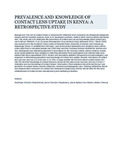| dc.contributor.author | Chikasirimobi, Goodhope Timothy | |
| dc.contributor.author | Chepkeitany, Harun Chemjor | |
| dc.contributor.author | Staden, Diane Wallace Van | |
| dc.contributor.author | Shaviya, Nathan | |
| dc.date.accessioned | 2022-11-16T08:56:38Z | |
| dc.date.available | 2022-11-16T08:56:38Z | |
| dc.date.issued | 2022-12 | |
| dc.identifier.uri | http://oapub.org/hlt/index.php/EJPHS/article/view/114 | |
| dc.identifier.uri | http://ir-library.mmust.ac.ke:8080/xmlui/handle/123456789/2126 | |
| dc.description.abstract | Background: The use of contact lenses is welcomed for refractive error correction, for therapeutic/diagnostic reasons and for cosmetic reasons, more so in developed countries, unlike in third world countries like Kenya. Aim: The study aim is to determine the prevalence of contact lens use and knowledge about contact lens use in Kenya. Methods: A six (6) years retrospective cross-sectional study (February 2014 – March 2020) was carried out in the Academic Vision center of Masinde Muliro University of Science and Technology, Kakamega, Kenya. A validated tool with open- and closed-ended statements and questions were used to collect data from a calculated sample size (360) that used the Cochrane formula modified by Sullivan and Soe. Participants was selected purposively in accordance to the inclusion criteria, phone contacts, emails, social media platforms were adopted in collecting information from participants and collected data were entered into Excel spreadsheet 2019. Version and Descriptive statistics (frequencies and percentages), was employed in determining prevalence and knowledge of contact lens uptake. Results: Prevalence of contact lens use was very low 4 (1.1%) and 11 (3.1%). A large number did not know about contact lenses 347 (96.7%) and the Knowledge of contact lenses as shown by the mean score was also very low 2.51±1.7 indicating very low knowledge of contact lenses. Conclusions: More emphasis should be laid by eye care providers on contact lenses used for refractive, cosmesis and therapeutic uses. Training institutions should also improve their curriculum on contact lens training and dispensing. Policies should allow for the easy establishment of contact lenses manufacturing and marketing industries. | en_US |
| dc.language.iso | en | en_US |
| dc.publisher | European Journal of public health studies | en_US |
| dc.subject | PREVALENCE, KNOWLEDGE, CONTACT LENS, UPTAKE, RETROSPECTIVE, STUDY | en_US |
| dc.title | PREVALENCE AND KNOWLEDGE OF CONTACT LENS UPTAKE IN KENYA: A RETROSPECTIVE STUDY | en_US |
| dc.type | Article | en_US |

